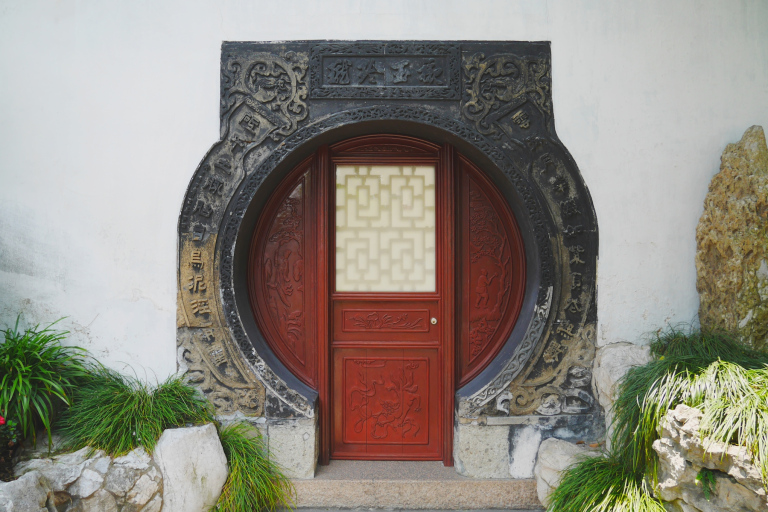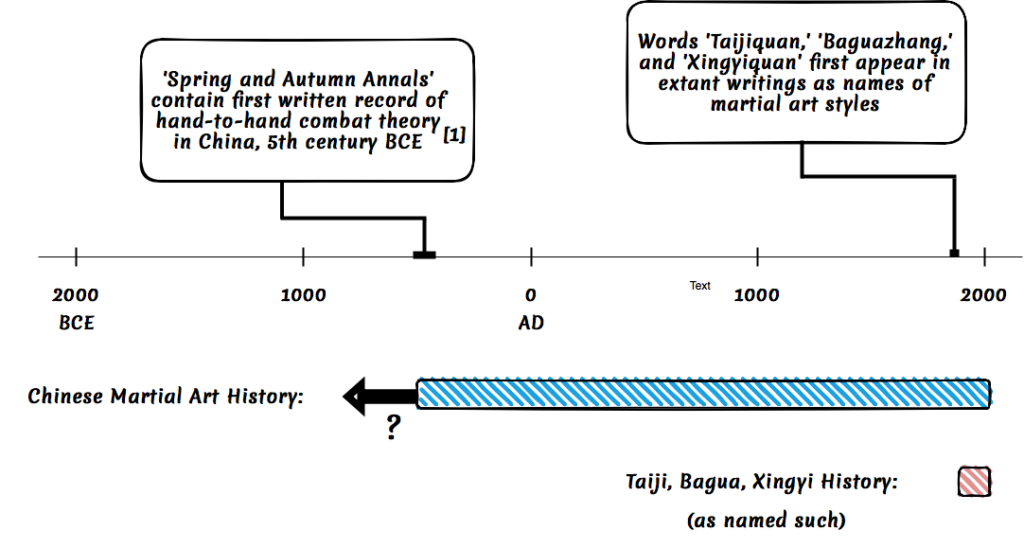Introduction Part I
“There are many other schools of martial arts besides this one. Although the postures are different between them, they generally do not go beyond the strong bullying the weak and the slow yielding to the fast. The strong beating the weak and the slow submitting to the fast are both a matter of inherent natural ability and bear no relation to skill that is learned. “
-Taiji Boxing Classic (Brennan Translation)
“If you have the power, everything works.”
– Grandmaster Feng Zhiqiang

[Author’s Note: This text was initially intended as introduction to an instructional video series, hence the reference to video . . . ]
The purpose of this video series is twofold: 1) to demystify and explain the learned strength of the Chinese martial arts, and 2) to show how to train safely and efficiently to realize that strength, and the explosive force expression known as “fajin.”
There are, of course, many mental and physical benefits of a combined meditation and physical exercise regimen. Whatever any individual’s motivation for practicing the Chinese martial arts is the best reason for that person. But it is undeniable that the common purpose of arts such as taiji, bagua, xingyi, and yiquan is to build the functional, efficient strength commonly referred to as “internal power.” Indeed, in the Chinese martial tradition it is precisely the absence of this power that was derisively referred to as “empty” practice. Once the power is developed martial strategy and technique can quickly be learned. But the development of internal power is the essential foundation of the training—even the sitting, standing, and lying down meditation practices all serve to develop specific mechanisms of internal power.
Not to go down the often romantic, partisan and/or nationalistic rabbit hole of Chinese martial history, I would note that this power training existed long before the words “taijiquan” or “xingyi” or “baguazhang” were even invented. (A little perspective: all of these names did not appear in writing until the later part of the 19th century when, for the first time, martial arts were taught commercially in China.)

[1] Henning, Stanley E. “The Maiden of Yue: fount of Chinese martial arts theory.” Journal of Asian Martial Arts 16, no. 3 (2007): 26+. Gale Academic OneFile (accessed July 13, 2021).
Nomenclature
Two quick words here about nomenclature.
First, I use the label “internal” strength only because it is commonly referred to as that. Personally I agree with the scholars that claim that the first use of the word “internal” to describe Chinese martial arts in the 17th century “Epitaph to Wang Zhengnan” was simply a political declaration of the superiority of martial arts indiginous, or “internal,” to China—as opposed to the “external” arts of Buddhist (i.e. foreign) origin—and a thinly veiled metaphor encouraging the native Chinese to resist foreign Manchu rulers at the time. Certainly as we have noted the names taijiquan, baguazhang, and xingyiquan didn’t exist until more than 200 years after the Epitaph was written.
However, as the excerpt from the taijiquan treatise quoted at the beginning of this video notes, there IS a distinction between brute force or natural ability—sometimes called “external strength”—and the learned power of the Chinese martial arts—comparatively referred to as “internal strength.” Of course ALL human force exertion is obviously generated from the musculoskeletal system. “Learned,” “hidden” (because the combined mechanisms of force generation are certainly not obvious to the uninitiated), “efficient,” “fluid” (as opposed to stiff) and/or “whole body force” are perhaps more apt descriptors. Call it anything you want—it is what it is, and it must be learned.
Second, though I may use the words interchangeably, there are technical distinctions between strength, force and power.
Force is energy transferred to something to make it move or change velocity and is given by the famous equation force=mass x acceleration (F=ma). It is a vector, meaning it is always associated with a direction: forces are either pushes or pulls. Except gravity and electricity/magnetism, which can act at a distance, ALL forces require physical contact. Any emotional energy can act upon or alter another’s thoughts, and therefore their actions, but to physically move any object you must be in contact with it and your body must have kinetic energy (i.e. you must be moving). If you are capable of demonstrating an exception to the scientific community, a Nobel prize in physics, and fame and fortune, await you.
Power is all about how quickly energy is transferred. It is the dot product of force and velocity: P=F.V . Power is a scalar quantity, meaning it is a number or magnitude only.
Strength is a generic term. Muscular strength is defined as the maximum force generated for an isolated exercise or movement, but endurance, stability, power, and neuromuscular efficiency all play a part of overall strength. In the Chinese martial arts we are really talking about all of them, so I have labeled the video series “internal strength.”
Of course “mental” strength and strategy/application/theory are also important in martial application. Indeed, most people experienced in combat sports, or any sport really, will tell you that the mental aspects are every bit as crucial to performance as physical abilities, and are absolutely what separates people of comparable physical skills. But this video series is about the mechanisms of physical strength trained in the Chinese martial arts—I have written a bit about the importance of mental attitude and aptitude, and application of taiji martial strategy, on our blog.
Training of physical attributes such as strength, balance, coordination, and footwork are fundamental to most martial arts, and the recognition of martial arts or combat sport training as methods of self-cultivation are certainly not unique to the Chinese arts. But there is one human body—two arms, two legs, and a core connecting them, and the brilliance of the Chinese martial arts is that they teach how to maximize the efficiency of human force exertion in terms of maximal force generation, minimal exertion, and agility in expressing force in any direction and with any part of the body. Just imagine you are a farmer toiling daily with hand tools (as many martial artists of old were), or a military soldier on a battlefield yielding a heavy sword or spear. (The weapons of old had to stand up under battlefield conditions and penetrate armor, and were much heavier than the thin, flexible ultra-light replicas commonly used in performance art today.) This is all extremely physically demanding work—efficient power is what is key to nurturing oneself and not quickly tiring. My personal experience has been that familiarity with routine hard labor is definitely a plus in understanding the mechanisms and application of learned power. . . though the Confucian literati later wrote fancifully about it, the learned power of the Chinese martial arts was born from folks doing hard and repetitive work and refined through centuries by martial arts practitioners experienced in combat.
A beautiful thing about the power of the Chinese martial arts is that it can be learned, safely trained, and increased well into one’s later life—regardless of natural ability. Indeed, the oral tradition holds that one does not reach a peak of martial ability until one’s 50s. Whether your interest is in the martial arts, or considerably improving power for ANY sport, for intelligent and efficient force exertion in daily labor, or simply for balance, strength, and agility well into your senior years, the methods of the learned power of the Chinese martial arts can be safely practiced and learned by ANYBODY. I can tell you that I am nearing 60 and can hit a golf ball further today with a 7-iron than I could with a wood in my 20’s. (Still can’t hit it straight, but that’s another thing . . .)
“The Classics”
Before jumping into the training, a quick word about the classical literature of the internal martial art tradition. The collections of written poems commonly referred to as the “classics” have done much to promote interest in the Chinese martial arts and to elevate them to a more respected intellectual or even spiritual status, both within the Confucian literati influenced culture of China (which, to say the least, did not initially highly value fighting arts) and also internationally. But, either intentionally or because the authors’ were limited by the scientific understanding and language of the 19th century, they are esoteric and easily susceptible to false or fanciful interpretations.
A good example is the famous saying in the taijiquan treatise that “four ounces are used to defeat 1000 pounds.” An inexperienced person could easily interpret this to mean, and come to believe, that physical force is deliberately avoided in taijiquan. Any such belief, however, is folly. The question one should ask here is “four ounces of what?” Though lightness/agility can certainly be a component of the effective neutralization of force, 1000 pounds will always, ultimately, squash 4 ounces of force. There are no exceptions to Newtonian physics (at least at the scale of human force exertion). The four ounces in this saying refers to the efficiency of force exertion. With the learned power of the Chinese martial arts, less effort is required to produce or withstand larger forces—WHY that is so will soon become quite apparent to you if you practice the exercises in this video series.
The ‘1000 pounds’ in the saying refers to brute force or natural ability, which is quickly exhausted. But make no mistake—the goal of practice is to develop considerable strength and power and to learn to express that strength efficiently, so that you do not quickly tire. Indeed, the development and expression of power is a central tenet of the classical literature—the words“power” or “powerful” occur some 30 times in taiji’s “Essentials of Playing Hands” and “Five Word Formula,” and over 50 times in Liu Dianchen’s xingyi manual alone. Grandmaster Feng’s statement is quite unambiguous—if you have the power, everything works.
Well enough with the intro—let’s get right on to listing the mechanisms of internal strength—and then start training to REALLY understand them, and in the process come to understand WHY the principles of practice are what they are.
* Always * ask * WHY? *
Introduction Part II—Mechanisms of Internal Power
To be continued . . .

When I was in Seattle at Master Chen Xiang workshop, he described 4 ounce deflect 1000 lbs like the steering wheel of a car. It only takes a few ounces of force to steer the 1000 lb vehicle. I thought that was an interesting way to describe it.
Great article Scott
Looking forward to part 2
Hi DJ-
I get it – the idea of leverage, agility, and timing in neutralization – the “leading to emptiness” thing. But that absolutely cannot be relied upon as defense against a skilled attacker who does not unbalance themselves (which is most anybody with basic training in combat sport). But the steering wheel uses power steering to magnify the force from the steering wheel to the wheel itself – so a large force is actually applied at the wheel. And really this is what internal power is – using less “effort” but still applying a large force. How this is all done is what I hope to explain.
Grandmaster Feng was quite famous for his power, as were many of the grandmasters of old. Besides the quote in the article, to convey the importance of power Grandmaster Feng would also point to his grandson when he was a very small child and say that there is nothing he could do to defend himself from a larger person with more power, regardless of what he (Grandmaster Feng) could teach him. The difference in power was just too great.